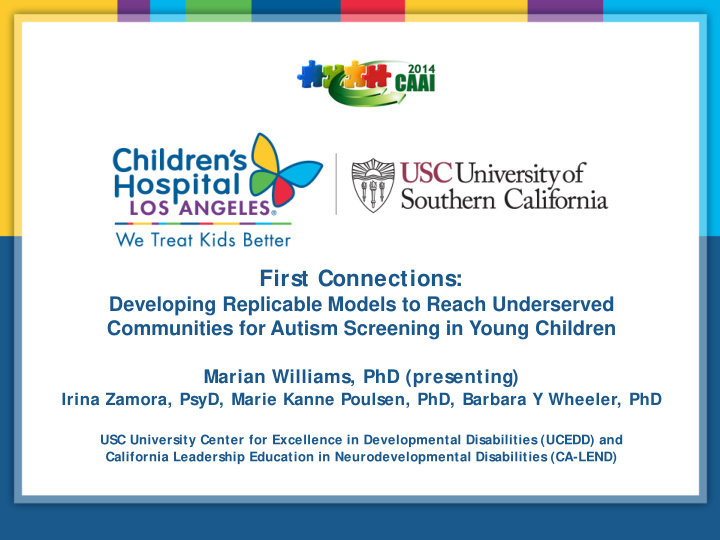



First Connections: Developing Replicable Models to Reach Underserved Communities for Autism Screening in Young Children Marian Williams, PhD (presenting) Irina Zamora, PsyD, Marie Kanne Poulsen, PhD, Barbara Y Wheeler, PhD USC University Center for Excellence in Developmental Disabilities (UCEDD) and California Leadership Education in Neurodevelopmental Disabilities (CA-LEND)
Introduction First Connect ions • 3-year proj ect, began January 2014 • Funded by First 5 Los Angeles • Partnership: • US C University Center for Excellence in Developmental Disabilities (Training and Technical Assistance Lead) • Three Federally Qualified Health Centers: • AltaMed • Eisner Pediatric • Northeast Valley Medical Center • Two family service agencies: • Foothill Family S ervice • Westside Children’s Center • Family Resource Center: • S outh Central Los Angeles Regional Center FRC 2
Methods • Train staff at six community agencies to conduct developmental screening with children ages birth to 5 years using AS Q-3, AS Q: S E, and M-CHAT-R • Develop work flows and algorithms to ensure universal screening and linkage for underserved and ethnic minority children living in poverty • Provide parent education, using CDC Learn the S igns Act Early materials • Develop relationships between medical and family service providers and family-run resource agencies and ethnic minority parent organizations • Develop strategies to link young children with early intervention and reduce access barriers • Train CA-LEND interdisciplinary trainees to provide TA and conduct community research 3
Screening Algorithm: Birth through 2 Years Optional: ASQ-3 & M-CHAT-R at ASQ:SE 15 to 30 months All: review screening results and CDC Developmental Milestones booklet with parent Score Over Cutoff ASQ-3 ASQ: SE or M-CHAT-R: Below cutoff Gray Area any domain over cutoff over cutoff Measure Low incidence Y disability? N Refer: Referral Options: Refer: • School District Low Incidence Refer: • Infant mental health • Early Head Start Disabilities (Deaf/Hard of • Regional Center Early program • Parent Education group Hearing, Vision Impairment, Start • Family Resource Center Orthopedic concern) • Parent Support group • Family Resource Center • Parent Education group • Family Resource Center • Baby & Me • Parent Education group • Parent support group • Parent support group First Connections Re-screen in 3 months July 2014
Draft Logic Model July 2014 Draft First Connections: Early Identification of Autism and other Developmental Disabilities in Underserved Communities Resources Activities Outcomes Impact • More providers Funding • Screen ages birth • Universal screening is [First 5 LA logo] to 5 years with competent to screen routine in Los Angeles ASQ-3, ASQ:SE, young children County across service M-CHAT-R Training and TA sectors and • Community linkages communities USC UCEDD at CHLA • Train staff in increase screening, linkage, • Working relationships Community Agencies outreach, parent • Young children access between medical AltaMed education early intervention & agencies and family Eisner Pediatric Foothill Family Service early childhood mental resource agencies lead Northeast Valley Health • Educate and health services to supported families So Central LA Regional Center’s support parents Family Resource Center • Parents recognize • Families experience Westside Children’s Center • Link families developmental seamless linkage to Partners with resources milestones and needs early intervention 211 Los Angeles County services • Identify and • Parents get support to Family Resource Centers Network reduce barriers meet children’s special Of Los Angeles County needs • Disseminate replicable models 6
Results Proj ect j ust began, but early outcomes include: • Development of model for universal developmental and autism screening by medical providers through integration with electronic medical record • Development of model for developmental and autism screening within diverse family service agencies reaching young children in ethnic minority, monolingual, and low income communities • Outreach and linkage model including Family Resource Centers, ethnic-focus parent partner organizations, disability-specific organizations, parent peer support, and clients rights advocates • Creation of opportunities for CA-LEND interdisciplinary trainees to learn to provide TA, conduct community-based research, and develop policy briefs related to early screening and intervention for autism and other developmental disabilities 7
Conclusions • Partnerships with diverse types of provider agencies leads to synergy/ different perspectives on – Work flows for different settings and types of providers – Ways to use technology to enhance follow-through and sustain change – How to reach and engage ethnic minority families from different communities • CA-LEND interdisciplinary trainees conduct meaningful leadership proj ects when linked with existing community and training grants; consider ways that trainees can: – Join with a faculty member to conduct training and TA activities – Write policy briefs using input from grant partners – Collect data to evaluate community-based proj ects 8
Discussion • Ways to build in sustainability from beginning of grant -funded proj ect • Ways to integrate LEND trainees in grant -funded proj ects so they learn all aspects of grant administration, development, and implementation • Ideas for dissemination of proj ect findings to constituents in legislature that make funding decisions For more information contact: Marian Williams at mwilliams@ chla.usc.edu 9
Recommend
More recommend